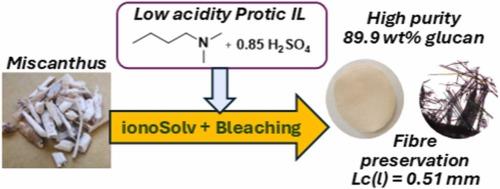Optimization of the ionoSolv process for the preservation of pulp fibre dimensions
IF 6.2
1区 农林科学
Q1 AGRICULTURAL ENGINEERING
引用次数: 0
Abstract
The pulping industry, dominated by century-old technologies, is highly polluting, making imperative finding more environmentally friendly alternatives. The ionoSolv process, based on the use of low-cost protic ionic liquids, is one of the most promising methods to fractionate lignocellulose with low ecological impact. However, this process has been only optimized to produce sugar-derived chemicals, where fibre quality is not a key factor. Earlier studies have shown the detrimental effect of the standard ionoSolv conditions on fibre length, which renders them unsuitable for fibre applications, including the production of paper. For the first time, this study shows the optimization of the ionoSolv fractionation of Miscanthus to preserve key fibre properties of the pulps, namely fibre dimensions, degree of polymerization and relative molecular mass, while maintaining optimal purity. Different temperatures (150 ºC and 170 ºC), retention times (45–90 min), and acid:base ratios (a:b = 1.00 to a:b = 0.55) were investigated. Fractionation at 170 ºC for 45 min with a reduced acid:base ratio of a:b = 0.86 allowed for maximum delignification (lignin content of 4.4 %) and preservation of fibre length. Pulps recovered under optimal conditions were bleached using a single stage method based on H2O2 increasing pulp purity, achieving optimal decolorization and retaining fibre dimensions comparable to those obtained from a commercial process (Lc(l) = 0.509 mm and Lc(w) = 0.775 vs Lc(l) = 0.540 mm and Lc(w) = 0.975). This highlights the potential of the ionoSolv process as a greener fractionation alternative to produce cellulose fibre materials.

离子溶胶工艺对纸浆纤维尺寸保存的优化
制浆工业由百年老技术主导,污染严重,迫切需要寻找更环保的替代品。ionoSolv工艺以低成本的质子离子液体为基础,是最有前途的低生态影响木质纤维素分馏方法之一。然而,这一过程只被优化为生产糖衍生化学品,其中纤维质量不是关键因素。早期的研究表明,标准离子溶剂条件对纤维长度有不利影响,这使得它们不适合纤维应用,包括造纸。本研究首次对芒草的离子溶剂分馏进行了优化,在保持最佳纯度的同时,保留了纸浆的关键纤维性能,即纤维尺寸、聚合度和相对分子质量。研究了不同温度(150ºC和170ºC)、保留时间(45-90 min)和酸碱比(a:b = 1.00至a:b = 0.55)。在170℃下分离45 min,酸:碱比降低为a:b = 0.86,可以最大限度地脱木质素(木质素含量为4.4 %)并保存纤维长度。在最佳条件下回收的纸浆采用基于H2O2的单阶段漂白方法,提高纸浆纯度,达到最佳脱色效果,并保留与商业工艺相当的纤维尺寸(Lc(l) = 0.509 mm和Lc(w) = 0.775 vs Lc(l) = 0.540 mm和Lc(w) = 0.975)。这突出了ionoSolv工艺作为生产纤维素纤维材料的更环保的分馏方法的潜力。
本文章由计算机程序翻译,如有差异,请以英文原文为准。
求助全文
约1分钟内获得全文
求助全文
来源期刊

Industrial Crops and Products
农林科学-农业工程
CiteScore
9.50
自引率
8.50%
发文量
1518
审稿时长
43 days
期刊介绍:
Industrial Crops and Products is an International Journal publishing academic and industrial research on industrial (defined as non-food/non-feed) crops and products. Papers concern both crop-oriented and bio-based materials from crops-oriented research, and should be of interest to an international audience, hypothesis driven, and where comparisons are made statistics performed.
 求助内容:
求助内容: 应助结果提醒方式:
应助结果提醒方式:


